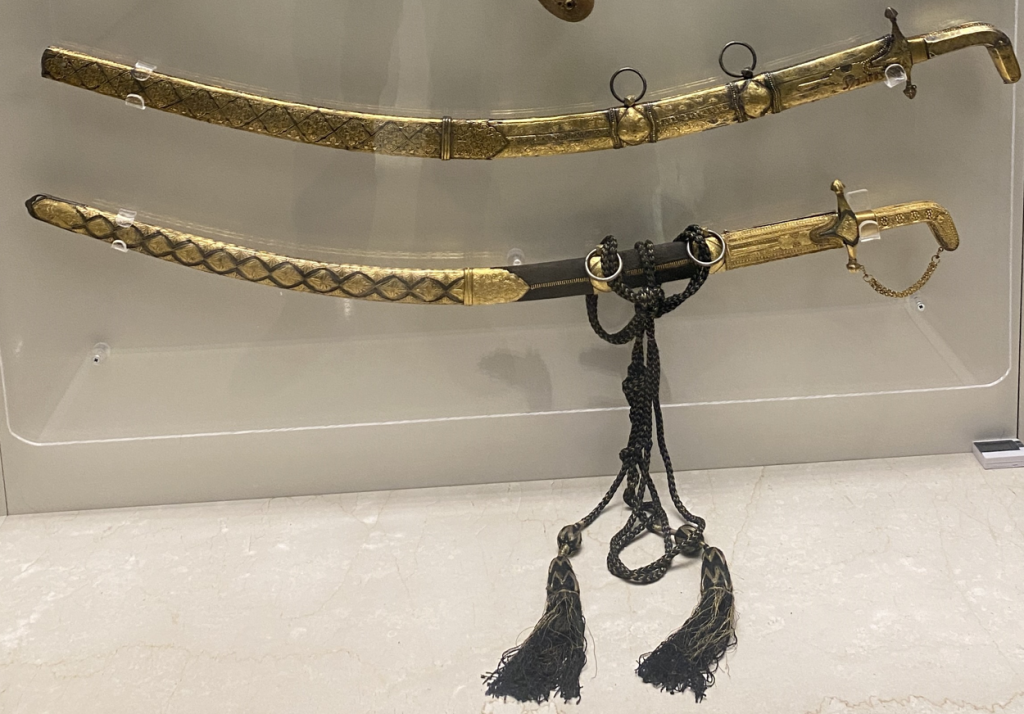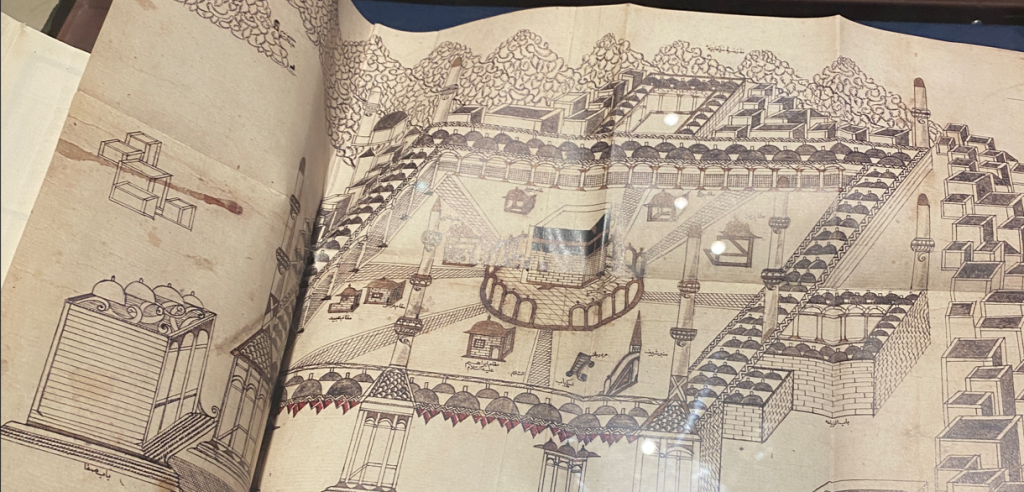
Field Research – Museum of Islamic Art
During my time back home in Egypt I visited the Museum of Islamic Art in Cairo. Within the museum are works stretching from between the middle ages and 19th century. It includes objects and pieces from several eras in Egypt that I’ve researched such as the Ayyubid dynasty, the Fatimid dynasty, the Mamluk dynasties, and the Ottoman rule. It also had a myriad of other artefacts from other nations such as Iran, Yemen, and Turkey, among others. It was relevant to my game as it includes many wondrous items that may be used as inspiration for designs within my game world.
Weapons & Armour
One of the most interesting aspects of the museum was the weapons & armour section which includes items stretching from between the Mamluk Sultanate (13th-15th century) and the Ottoman empire (18th-19th century). There were swords, guns, helmets, and more. Each piece was intricately designed and I found each of them to be good sources of inspiration for my own designs.




These swords, daggers, and scabbards are masterful metalworks and artistic pieces. They are also larger than they appear on photography, which bolstered my confidence in making my protagonist’s sword two-handed, as it is not as unreasonable as I thought at first for someone in that era to have such a sword. I particularly liked the designs of the scabbards, they were full of intricately crafted engravings. I especially liked the scabbard with the tassels and I may incorporate such a design for one of my characters. The variation between swords also inspired me to design more varied weapons and to not restrict myself as much as I thought I should.

I found the armour and other items interesting. The chain mail and helmet was very large and imposing; seeing armour in person always reinforces that these wears were not simply cool-looking metallic clothes but actually existed to serve the purpose of protection. The shield was slightly underwhelming as it was smaller than I expected, but considering how mamluk soldiers fought, it makes sense that they wouldn’t carry around a large cumbersome shield. It made me consider the practicality of carrying all of these at once, which is something I may consider in future designs. The arrows were very intriguing due to how deadly they appeared, they had defined and sharp edges and looked serrated, so being hit by one would hurt, but pulling it out would probably hurt more. This specific display reinforced to me the fact that these objects were indeed used for practical purposes, and that these purposes included either protection from death, or inflicting it on others. As a result, I have a stronger appreciation for such items.

The design of these guns are wonderful. The inlaid metals and engraving marks are incredibly complex and intricate, making them very appealing to gaze at. The larger rifles also have smaller, yet intriguing, designs as well. I’ve always had an affinity for the design of older weapons, and in researching middle eastern armies and soldiers I came across many artworks depicting soldiers wielding such weapons which made the design more so appealing. As a result, seeing these weapons in person was gratifying. The pistols were also much larger than I thought they would be which was interesting. Overall these guns were inspiring and while my game is set in an era before gunpowder weapons are widespread, I can still incorporate such designs in my game, and I may make slight adjustments in the game world to accommodate such designs as I found them very appealing.
Art

This rug (among others I did not photograph) was inspiring. The intricacy of modern rugs are something I take for granted often, since most modern works are made in factories on assembly lines, so seeing such intricate designs from an era where modern robotics and automation didn’t exist (or at least not in a very practical way) gave me an appreciation for such designs. I also took inspiration from the way in which the men on this particular rug were depicted. I may use these designs as a basis for how my own characters may appear and the art style of my game as a whole.






I have a great appreciation for these artworks. In an era where artists didn’t have static photos they could focus on for hours or consistent lighting, being able to render scenes and people as well as they did with the limited tools they had fills me with inspiration and respect for these great artists. I particularly liked the isometric depictions of cities seen in the compass and manuscripts. It must have required careful observation and proficient skills in order to be able to render such scenes as well and as accurately as these artists did. The overall style of these works are, in comparison to the modern age, simplistic, however this has given motivated me to maintain a simpler art style for my game as a sort of callback to these older works. Of course my game will be going for a pixel aesthetic, but in regards to my approach to creating sprites and scenes, I will maintain one that is simple and effective, similar to how these artists rendered their works.
Miscellaneous

This object was of particular interest to me as I had studied the magical practices before visiting the museum. Seeing a real talismanic object “in the flesh” was wondrous. The shirt is much larger than it appears on photograph (in reality its closer to a gown than shirt) and the many symbols and markings over it were breathtaking to behold. It was clear that the creation of this talisman must have taken countless hours to complete, there are thousands of numbers and letters scattered (in an orderly fashion) across the shirt. It has inspired me in how I may go about designing the clothing of the mystical and magical characters within my game world.


Arabic calligraphy for me is somewhat unremarkable as I grew up seeing it everywhere in houses and at mosques and cultural locations. However, I still have an appreciation for it and the effort it takes to make such works and I particularly liked these stone tablets for their symmetry and age. I may include designs that evoke the aesthetic of Arabic calligraphy in my game world.

All these objects characterized the middle ages in the Islamicate world very well. They show off the esoteric (talisman) aspects as well the aspects of daily life (Iranian objects and stone tablets) as well as the general artistry that was present in this era (stained glass). They gave me inspiration for an aesthetic that cities and settlements in my game world may utilize, one that blends these various works together.
Conclusion
Overall, this museum visit filled me with inspiration and a deeper appreciation for the artists of the middle ages. I garnered several ideas from this visit that will assuredly impact my game and the aesthetic present within it.


2 thoughts on “Field Research – Museum of Islamic Art”